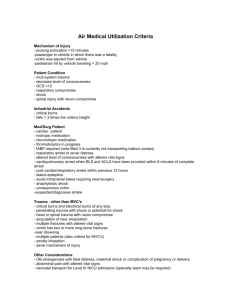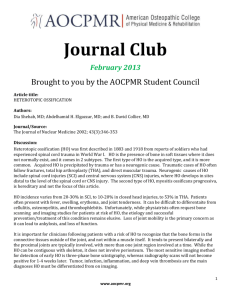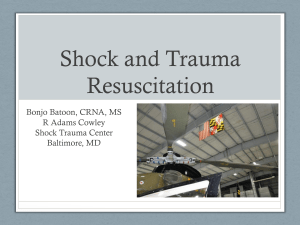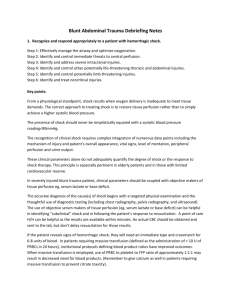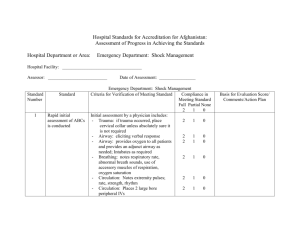Trauma
advertisement
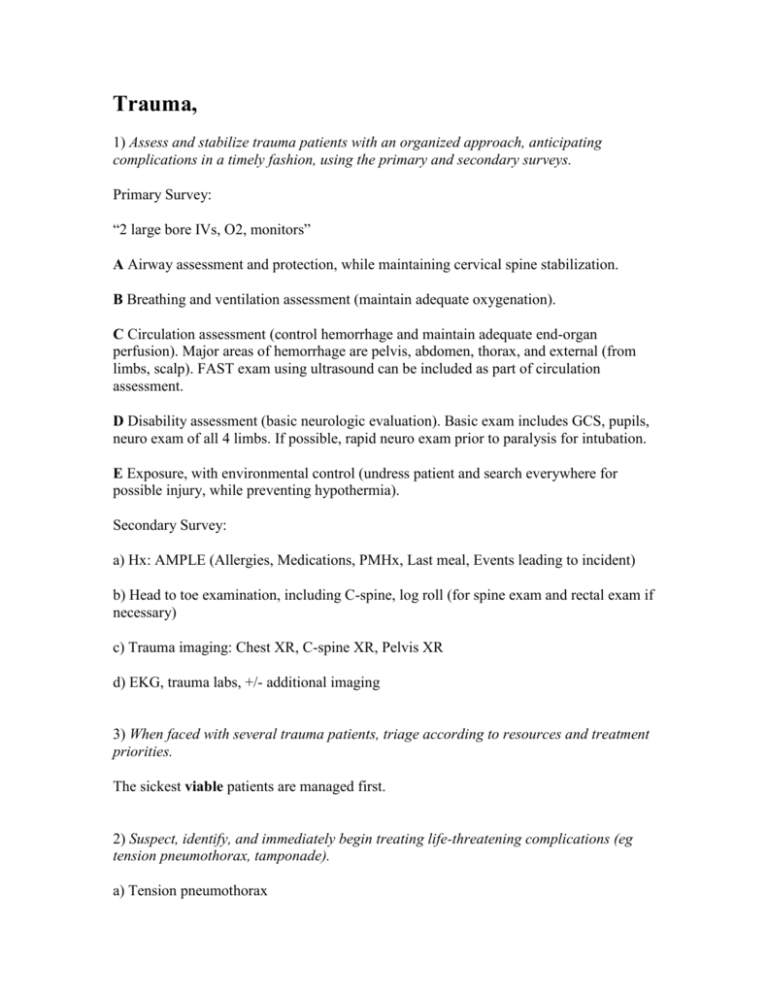
Trauma, 1) Assess and stabilize trauma patients with an organized approach, anticipating complications in a timely fashion, using the primary and secondary surveys. Primary Survey: “2 large bore IVs, O2, monitors” A Airway assessment and protection, while maintaining cervical spine stabilization. B Breathing and ventilation assessment (maintain adequate oxygenation). C Circulation assessment (control hemorrhage and maintain adequate end-organ perfusion). Major areas of hemorrhage are pelvis, abdomen, thorax, and external (from limbs, scalp). FAST exam using ultrasound can be included as part of circulation assessment. D Disability assessment (basic neurologic evaluation). Basic exam includes GCS, pupils, neuro exam of all 4 limbs. If possible, rapid neuro exam prior to paralysis for intubation. E Exposure, with environmental control (undress patient and search everywhere for possible injury, while preventing hypothermia). Secondary Survey: a) Hx: AMPLE (Allergies, Medications, PMHx, Last meal, Events leading to incident) b) Head to toe examination, including C-spine, log roll (for spine exam and rectal exam if necessary) c) Trauma imaging: Chest XR, C-spine XR, Pelvis XR d) EKG, trauma labs, +/- additional imaging 3) When faced with several trauma patients, triage according to resources and treatment priorities. The sickest viable patients are managed first. 2) Suspect, identify, and immediately begin treating life-threatening complications (eg tension pneumothorax, tamponade). a) Tension pneumothorax - if suspected, treat with needle decompression prior to obtaining Chest XR (14G angiocath in 2nd ICS, midclavicular) - needle decompression must be followed by chest tube (4th-5th ICS, anterior axillary line) b) Cardiac tamponade - ER needle aspiration, or to OR if available 4) In trauma patients, secure the airway appropriately (eg assume cervical spine injury, use conscious sedation, recognize a difficult airway, plan for back-up methods / cricothyroidotomy). Assessment for difficult airway: L Look (trauma, teeth, hair, large tongue) E Evaluate 3-3-2 (what you want is mouth opening to fit 3 fingerbreadths, submandibular length 3 finger-breadths, hyoid to cricoid 2 finger-breadths) M Mallampati score (you want 3 or 4) O Obstruction, any signs of? Sleep apnea? N Neck mobility (neck arthritis, C-spine collar) Assessment for difficult BVM ventilation: B Beard O Old O Obese T Toothless S Snores 5) In a patient with signs and symptoms of shock: a) Recognize the shock. Pre-shock: - <10% loss of effective blood volume - compensated shock - tachycardia, +/- modest BP change Shock: - 20-25% loss of effective blood volume - s/s organ dysfunction appear - tachycardia, BP drop, dyspnea, diaphoresis, restlessness, oliguria, cool / mottled skin End-organ dysfunction: - untreated shock progresses to end-organ dysfunction and death (renal failure, acidosis, obtundation) b) Define the severity and type (eg neurogenic, hypovolemic, septic). Hypovolemic shock: - Decreased preload due to intravascular volume loss. - DDx: hemorrhage, fluid loss Cardiogenic shock: - Cardiac pump failure. - Cardiomyopathies, MI, arrhythmias Distributive shock: - severely decreased systemic vascular resistance. - DDx: sepsis, SIRS, anaphylaxis, neurogenic (neurogenic shock is disruption of autonomic pathways causing decreased systemic vascular resistance) Combined shock: - combination of the above c) Treat the shock. - Bolus 20cc/kg crystalloid - with hemorrhage give blood soon - massive transfusion protocols (eg 1:1:1 pRBCs:platelets:FFP) 6) In trauma patients, rule out hypothermia on arrival and subsequently (as it may develop during treatment). 7) Suspect certain medical problems (eg seizure, drug intoxication, hypoglycemia, attempted suicide) as the precipitant of the trauma. 8) Do not move potentially unstable patients from treatment areas for investigations (eg to Xray, CT). If you need imaging urgently, a capable physician should accompany the patient. 9) Determine when patient transfer is necessary (eg CNS bleeds, when no specialty support is available). This is very dependent on the center you’re practicing in. 10) Transfer patients in an appropriate manner (ie stabilize them before transfer and choose the method, such as ambulance or flight). This is very dependent on the center you’re practicing in. Consider intubation for transfer. Indications for intubation include: - oxygenation - ventilation - expected clinical course (eg with GCS<8 intubate to prevent aspiration, or with transfer intubate if at all suspecting decompensation during transfer) 12) In children with traumatic injury, rule out abuse. Hx factors suspicious for abuse: - Hx inconsistent with injuries - Vague or inconsistent Hx - Injury attributed to actions of other siblings Px findings suspicious for abuse: - injuries not consistent with Hx - multiple fractures or injuries - likely inflicted injuries (cigarette burns or patterned bruises) - bruising in a child that is not yet “cruising” (normally 9-12mo) - bruising to pinna, neck, abdomen - genitalia injury 11) Find opportunities to offer advice to prevent or minimize trauma (eg do not drive drunk, use seatbelts and helmets).
